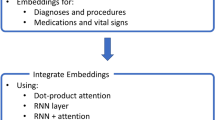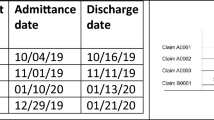Abstract
Hospital readmissions are frequent and costly events. Early risk prediction can lead to more effective resource planning and utilization. This paper presents a deep learning framework for predicting the risk of 30-day all-cause readmission given a patient journey dataset. The problem is posed as a binary classification. A novel personalized self-adaptive feature learning and embedding strategy is applied to learn the representations of patient journeys. We first introduce a Variable Attention module to capture the interdependencies of clinical features and generate attention feature representations. We then place a convolutional neural network (CNN) on the generated feature representations to estimate outcome probabilities. Demographic features, including sex and age, are then incorporated into a personalized representation used for adaptively fixing the output of CNN by modifying the network loss function. We successfully predict 30-day all-cause risk-of-readmission with area-under-receiver-operating-curve (AUROC) ranging between 0.838 to 0.858 and overall maximum accuracy of 77.34%.
Access this chapter
Tax calculation will be finalised at checkout
Purchases are for personal use only
Similar content being viewed by others
References
Jencks, S.F., Williams, M.V., Coleman, E.A.: Rehospitalizations among patients in the medicare fee-for-service program. N. Engl. J. Med. 360(14), 1418–1428 (2009)
Atkins, E.R., Geelhoed, E.A., Knuiman, M., Briffa, T.G.: One third of hospital costs for atherothrombotic disease are attributable to readmissions: a linked data analysis. BMC Health Serv. Res. 14(1), 1–9 (2014)
Zhou, H., Della, P.R., Roberts, P., Goh, L., Dhaliwal, S.S.: Utility of models to predict 28-day or 30-day unplanned hospital readmissions: an updated systematic review. BMJ Open 6(6), e011060 (2016)
Reddy, B.K., Delen, D.: Predicting hospital readmission for lupus patients: an RNN-LSTM-based deep-learning methodology. Comput. Biol. Med. 101, 199–209 (2018)
Vaswani, A., et al.: Attention is all you need. In: Advances in Neural Information Processing Systems, pp. 5998–6008 (2017)
Cai, X., Gao, J., Ngiam, K.Y., Ooi, B.C., Zhang, Y., Yuan, X.: Medical concept embedding with time-aware attention. In: Proceedings of the 27th International Joint Conference on Artificial Intelligence, pp. 3984–3990 (2018)
Collobert, R., Weston, J., Bottou, L., Karlen, M., Kavukcuoglu, K., Kuksa, P.: Natural language processing (almost) from scratch. J. Mach. Learn. Res. 12(ARTICLE), 2493–2537 (2011)
Berry, J.G., et al.: Age trends in 30 day hospital readmissions: us national retrospective analysis. BMJ 360 (2018)
Maali, Y., Perez-Concha, O., Coiera, E., Roffe, D., Day, R.O., Gallego, B.: Predicting 7-day, 30-day and 60-day all-cause unplanned readmission: a case study of a Sydney hospital. BMC Med. Inform. Decis. Mak. 18(1), 1–11 (2018)
McIlvennan, C.K., Eapen, Z.J., Allen, L.A.: Hospital readmissions reduction program. Circulation 131(20), 1796–1803 (2015)
Lemaître, G., Nogueira, F., Aridas, C.K.: Imbalanced-learn: a Python toolbox to tackle the curse of imbalanced datasets in machine learning. J. Mach. Learn. Res. 18(1), 559–563 (2017)
Nori, H., Jenkins, S., Koch, P., Caruana, R.: InterpretML: a unified framework for machine learning interpretability. arXiv preprint arXiv:1909.09223 (2019)
Lin, M., Chen, Q., Yan, S.: Network in network. arXiv preprint arXiv:1312.4400 (2013)
Author information
Authors and Affiliations
Corresponding author
Editor information
Editors and Affiliations
Rights and permissions
Copyright information
© 2022 Springer Nature Switzerland AG
About this paper
Cite this paper
Liu, Y., Qin, S. (2022). Hospital Readmission Prediction via Personalized Feature Learning and Embedding: A Novel Deep Learning Framework. In: Fujita, H., Fournier-Viger, P., Ali, M., Wang, Y. (eds) Advances and Trends in Artificial Intelligence. Theory and Practices in Artificial Intelligence. IEA/AIE 2022. Lecture Notes in Computer Science(), vol 13343. Springer, Cham. https://doi.org/10.1007/978-3-031-08530-7_8
Download citation
DOI: https://doi.org/10.1007/978-3-031-08530-7_8
Published:
Publisher Name: Springer, Cham
Print ISBN: 978-3-031-08529-1
Online ISBN: 978-3-031-08530-7
eBook Packages: Computer ScienceComputer Science (R0)




